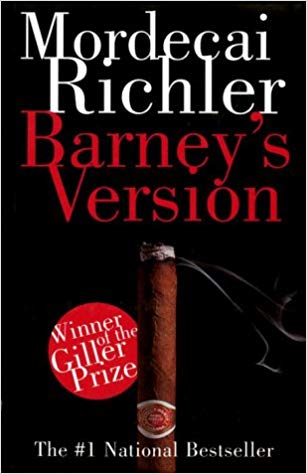
Barney’s Version, this afternoon. Yesterday, I finished rereading Mordecai Richler’s novel. Now, I’m sitting here with a glass of 14 year old Oban single malt scotch whisky and am toying with the idea of lighting a Montecristo while I reflect on the differences between the film and the novel. I won’t light it, of course. My wife would come at me like the second Mrs. Panofsky and harangue me into submission.
Which leads me to the first big difference between the film and the novel — the second Mrs. Panofsky. While most of the actors conform quite neatly to my preconceived notions of Richler’s characters (and Paul Giamatti is brilliant as Barney Panofsky), I had envisioned someone more corpulent for Barney’s second wife. Someone full-bodied as a young woman and tending to obesity later in life. While Minnie Driver does the annoying wife well enough, she couldn’t do obese if her life depended on it.
Then there’s the matter of tone. The book is Barney’s version, which is to say the story is told in the first person. It is laced with tall tales, drunken recollections, off-colour jokes, a foul tongue, and pranks that sometimes go too far. The film doesn’t use a narrative voice and opts instead for a more detached presentation. That makes it appear more objective. We lose the sense that maybe Barney is pulling our leg. What we get instead is a more serious tale. Not that it isn’t without its lighter moments. But by the end of the film, the dominant mood is pathos as we watch Barney’s personality disappear with the ravages of Alzheimer’s disease. Who knew Richler could be so serious?
I wish there had been more of the book’s cheekiness. For example, the film retains the incident involving a deposit of shit on the steps of a synagogue. It is Barney’s uncle, Irv Nussbaum, who relates the incident. Irv is a major fund-raiser for Israel and is recruiting Barney as a campaigner. In the film, Irv tells it straight — leaving shit on the temple steps is a sad instance of anti-Semitism. But in the novel, Richler gives the account a wry twist. Whether it was Québec separatism or Westmount WASPs or Trudeau federalism or Canada’s official cultural institutions, Richler regarded them all as fair game. And Zionism didn’t get a pass. In the novel, Irv Nussbaum is delighted there’s shit on the steps of a synagogue; it makes fund-raising so much easier. There’s nothing worse than a year without anti-Semitism. Sadly, Richler’s more acerbic tendencies are absent from the film. Probably the filmmakers didn’t want to offend anybody. Yet that was Richler’s chief virtue: he was unafraid to give offense.
But in my view, the most significant difference is that the film gives short shrift to Paris and Toronto. The film shifts those scenes to Rome and New York City. The reason is obvious — the producers wanted to expand the potential audience. Barney’s Version (the book) was enormously popular in Italy, selling more than 700,000 copies there. Why not reward their loyalty? And as for the shift to NYC, even Richler dissed Toronto, so it’s almost as if he gave the screen writer license to make the change.
I leave you with a passage about Toronto that reveals Richler in all his glorious cynicism:
Self-satisfied Toronto is not a city I’ve ever warmed to. It’s this country’s counting house. But plunging into the rush-hour din on Avenue Road that warm evening in early May, a spring in my step, I was in a forgiving, happy-to-be-alive mood. After all, the trees were plump with buds. If the clusters of daisies on display in buckets outside fruit stores were spray-painted orange or purple, they were redeemed by pristine bunches of daffodils. Some of the office girls passing in pairs in their summer dresses were undeniably pretty. Such was my rapture that I guess I smiled too broadly at the young mother coming toward us, wheeling a toddler in a stroller, because in response she frowned and quickened her pace. For once, I didn’t mind a sweaty jogger in shorts, running in place as he waited for a traffic light to change. “Wonderful evening, isn’t it?” I sang out, and he immediately patted his back pocket to ensure that his wallet was still there. Possibly I shouldn’t have paused to admire a brand-new Alfa Romeo parked in front of an antique shop, as this propelled its owner to the front door, glaring at us. Somewhere, higher up, we came upon a small park and I thought we might rest a while on one of its benches, but the gate was padlocked, and a sign screwed into the railing read:
NO EATING
NO DRINKING
NO MUSIC
NO DOGSSqueezing Miriam’s hand, I said, “Sometimes I think what inspires this city, its very mainspring, is the haunting fear that someone, somewhere, may be happy.”
